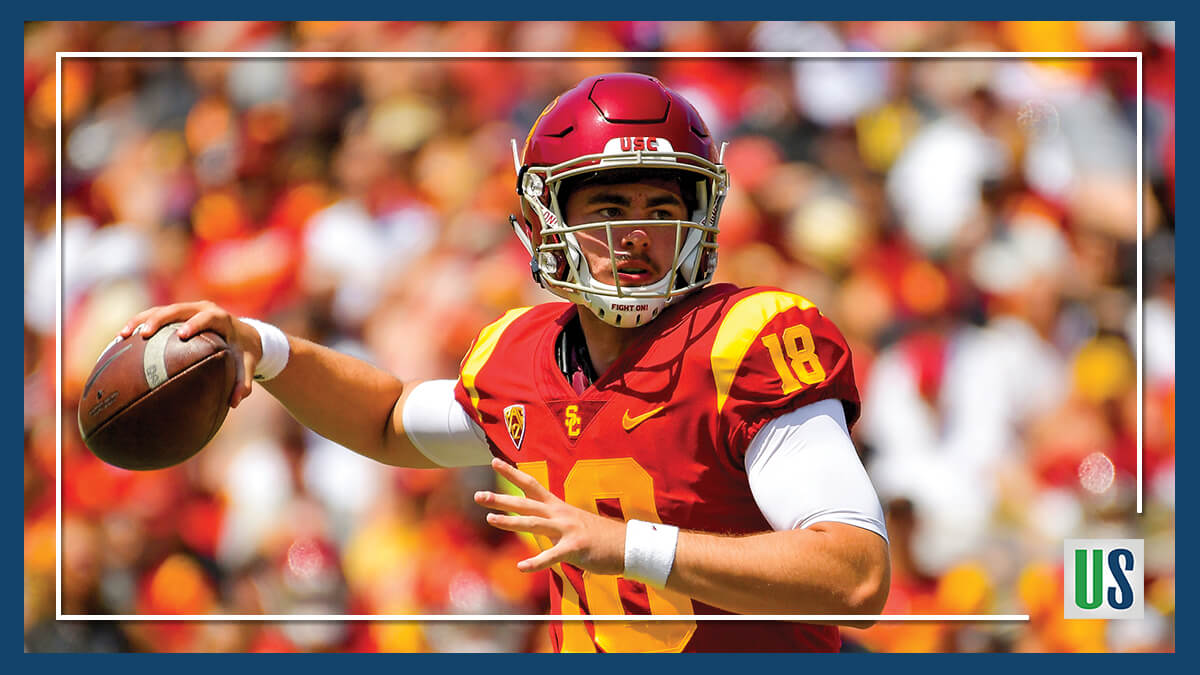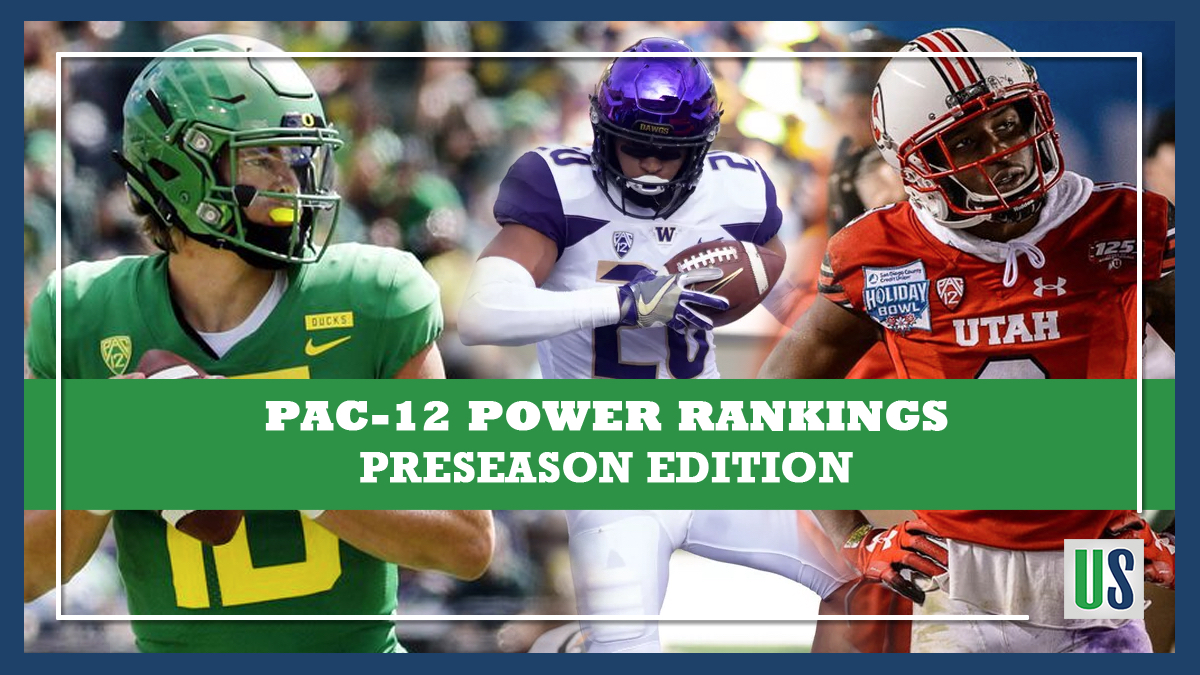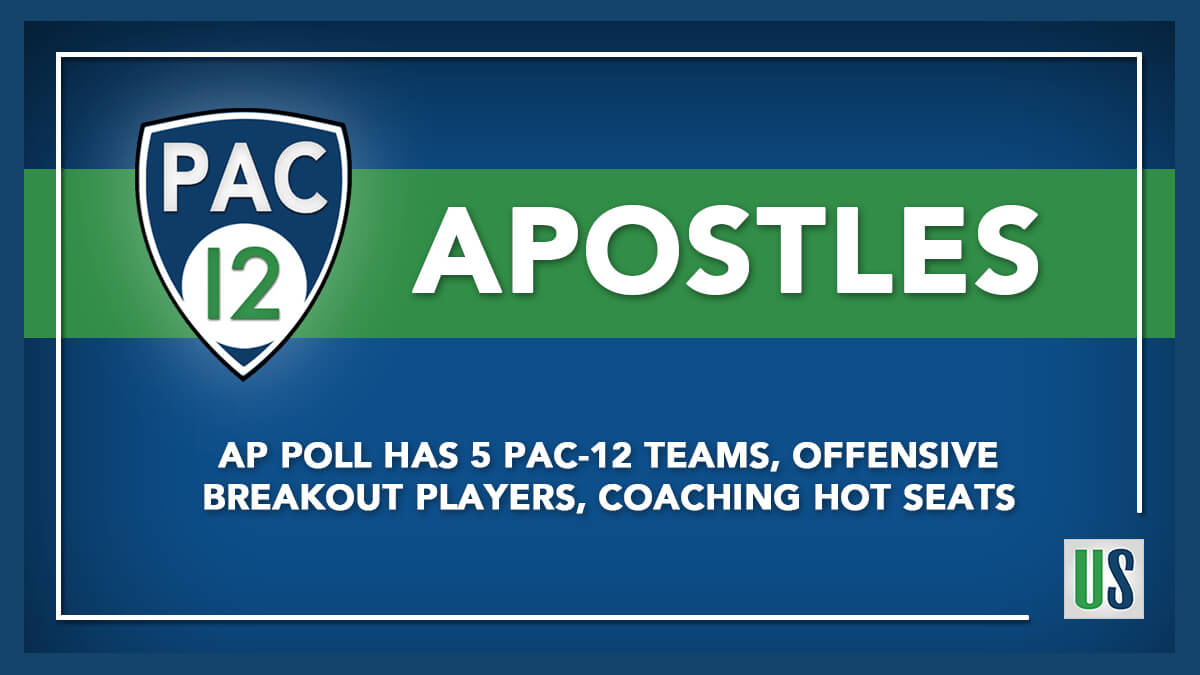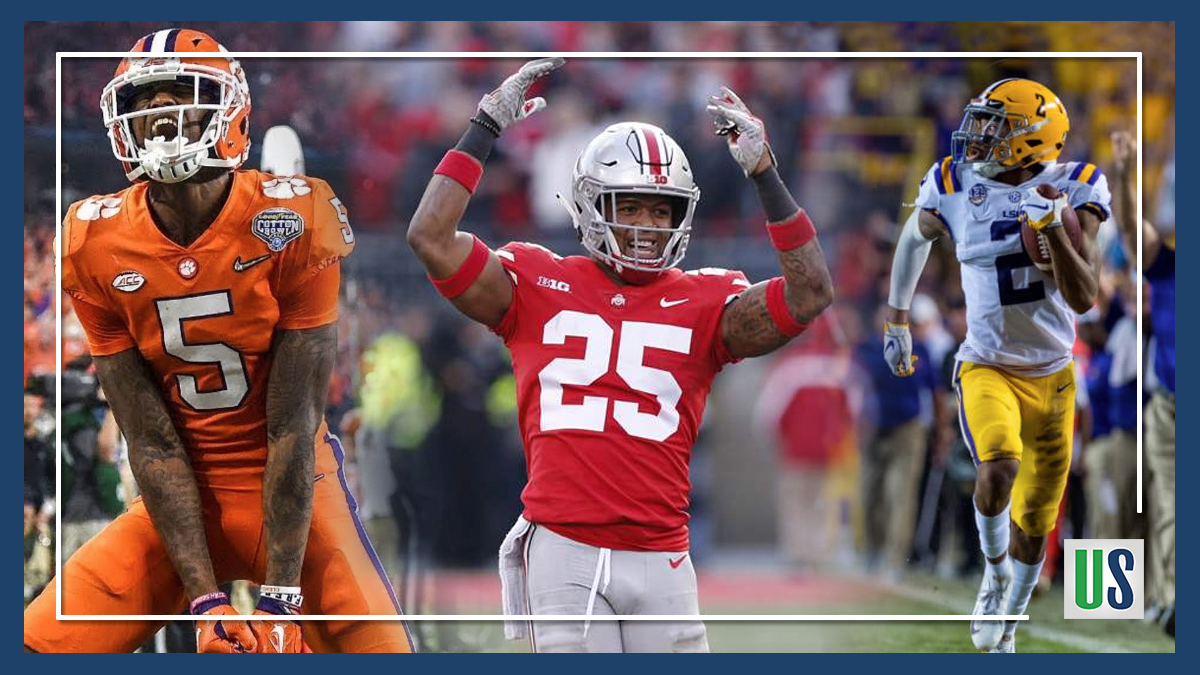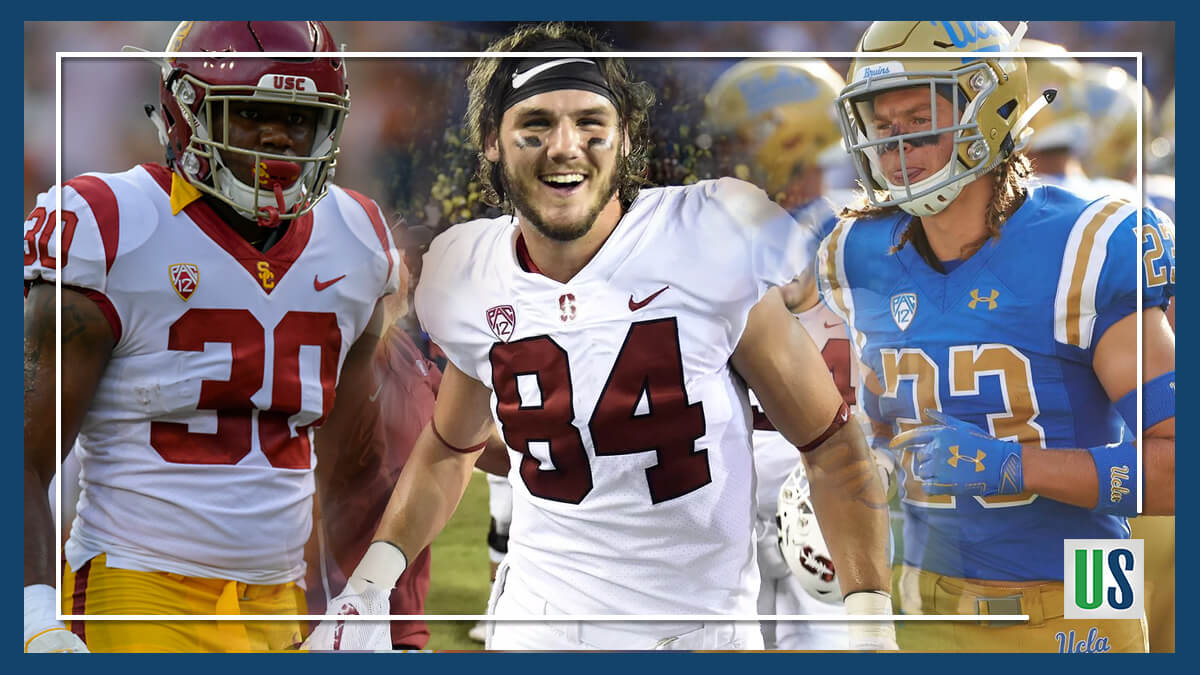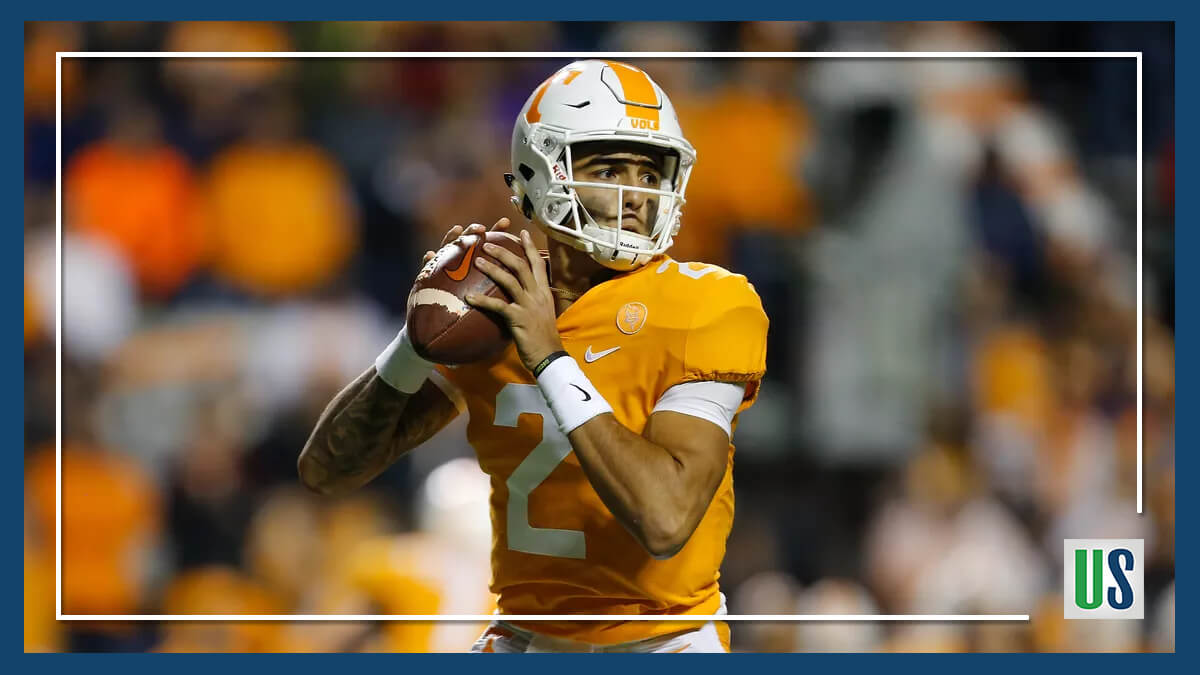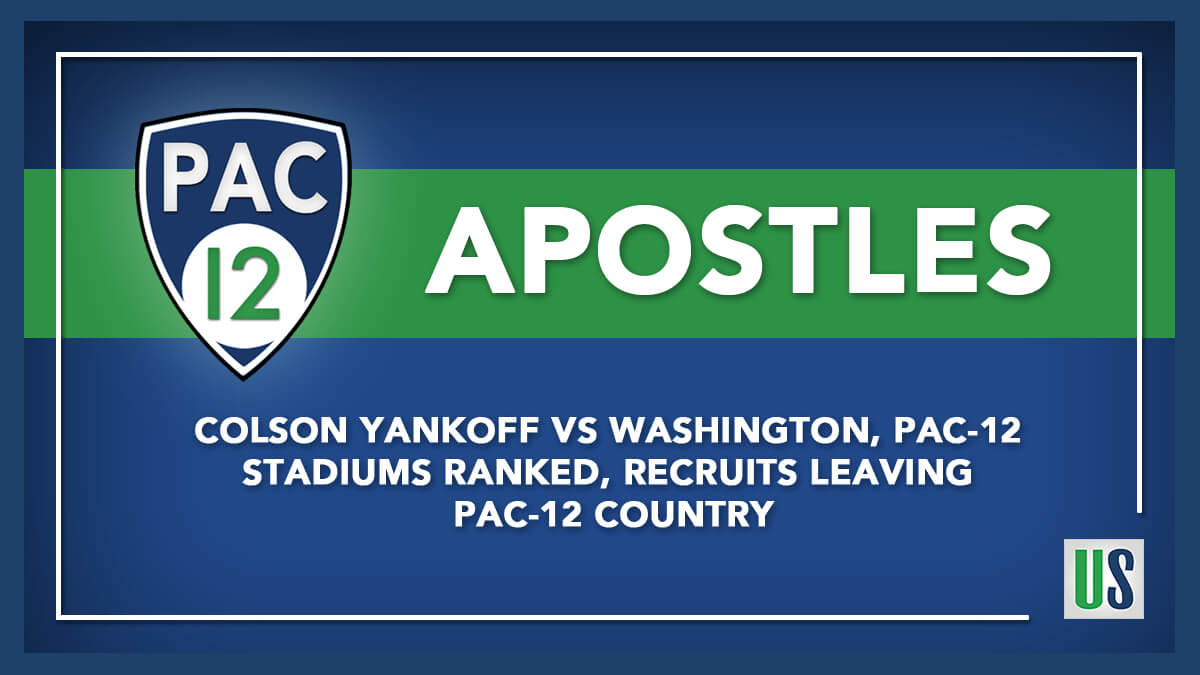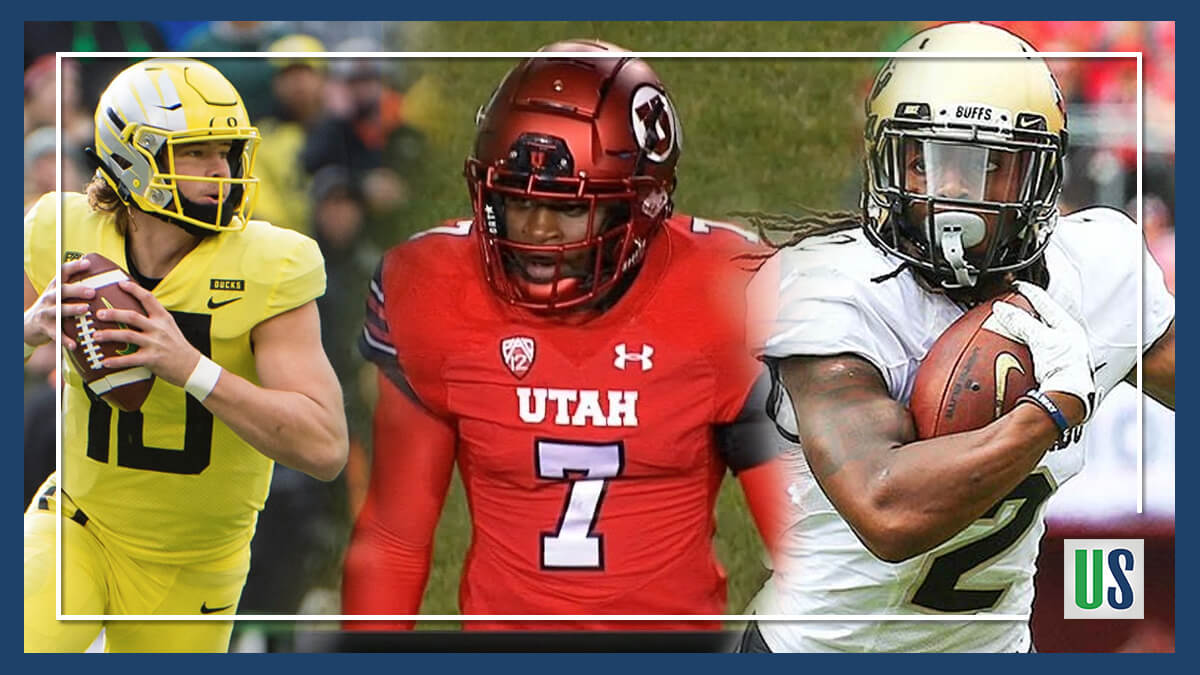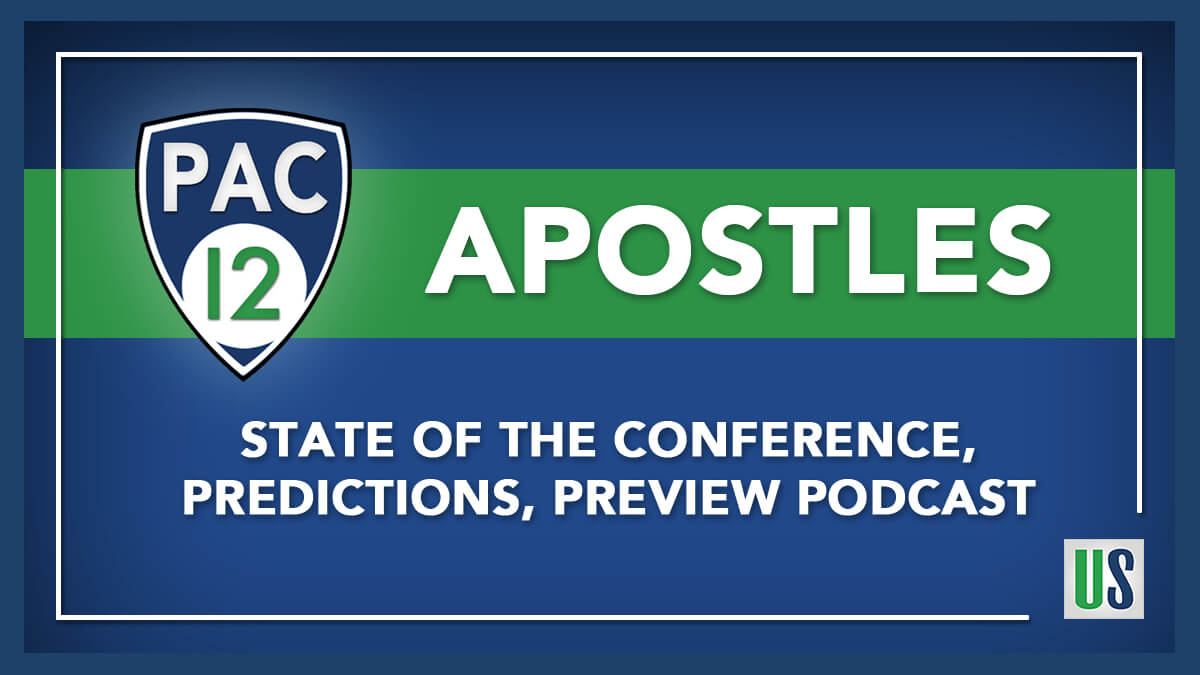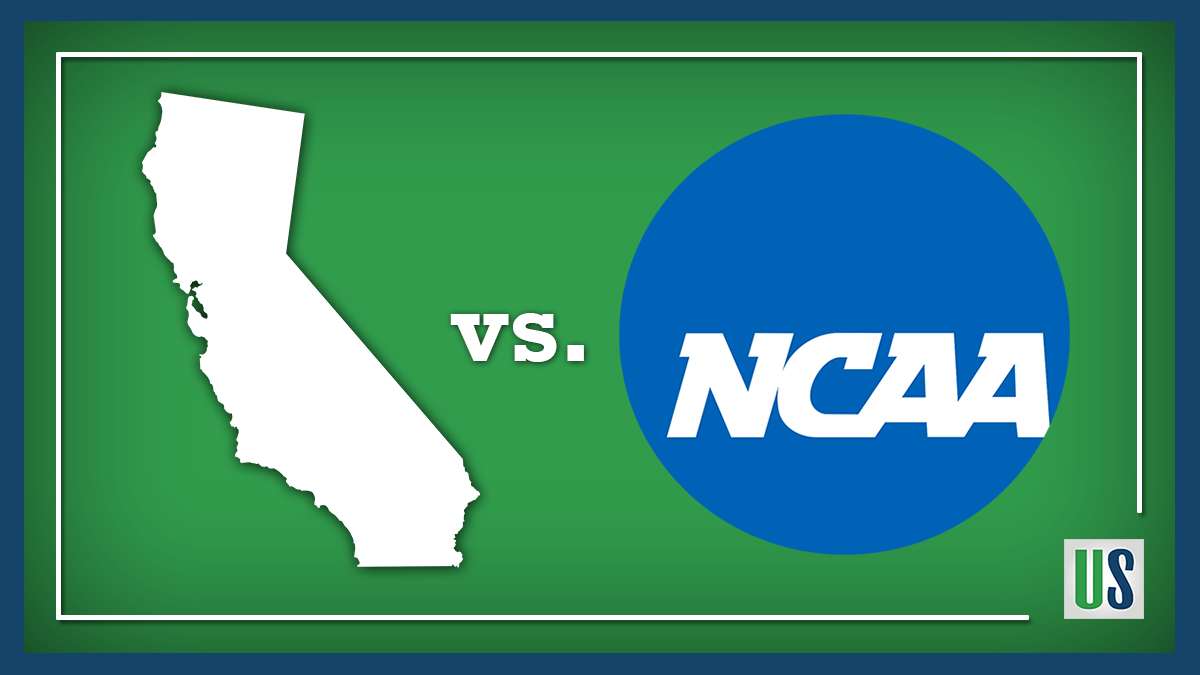The phrase west coast, best coast is true in a lot of ways, especially when it comes to taking in college football games.
Continue readingPac-12 Football Preseason Power Rankings 2019-20
Welcome to the Pac-12 Preseason Power Rankings. A team from the Pac-12 has a real chance to make the College Football Playoffs in 2019. The conference starts off with five teams in the preseason AP Poll. Oregon, Washington, and Utah all start the season ranked inside the AP top 14. The conference has a chance to quiet all the outside noise about money and tv deals, and the Pac-12 network by winning a national championship. Join and participate in the new Pac-12 Sports Subreddit for all your Pac-12 news, info, and smack talk.
Pac-12 Preseason Power Rankings:
The Pac-12 Power Rankings will available on Unafraid Show every Monday morning. Make sure you send your comments and grievances to immad@unafraidshow.com.
12. Oregon State Beavers
The Beavers should be markedly better in Jonathan Smith’s second season as head coach. Oregon State returns their top passer, running back, wide receiver, and top nine tacklers from last season. They finished 2018 with a 2-10 record and lost nine games by 17 points or more, so truthfully, there is nowhere to go but up. The best thing they have going is Sophomore running back Jemar Jefferson. He finished 4th in the conference in running as a freshman last year with 1,414 yards. Fans should expect another 2-10 season, but the games should be much more competitive.
11. Colorado Buffaloes
Mel Tucker’s first season as head coach of the Colorado Buffaloes should not be a bad one. He did not inherit a full rebuild like Jonathan Smith at Oregon State. Tucker returns veteran QB Steven Montez who has won big games. And they have the best offensive weapon in the conference WR Laviska Shenault.
The Buffaloes started last season 5-0 with wins over Nebraska, UCLA, and Arizona State. The back half of their schedule was much tougher, but losing seven games in a row seems more of a loss of confidence and focus than just being terrible.
10. Arizona Wildcats
The biggest wildcard in the Pac-12 is the Wildcats. On paper, this team looks very average. Their players don’t have a ton of recruiting stars behind their names, but when they play as a team they can be a force. If QB Khalil Tate can rekindle the magic from his sophomore season that landed him on magazine covers before last season, the Wildcats will make a bowl game. The combination of Tate and RB JJ Taylor in the read-option can a nightmare for defenses. But, can head coach Kevin Sumlin convince Tate not to worry about proving his passing abilities to NFL scouts and just play to his strengths?
9. Arizona State Sun Devils
A year ago so many people were questioning the hiring of Herm Edwards as ASU head coach. They said he was too old, hadn’t coached recently, and his “NFL model” would not work. Then the Sun Devils went 7-6, made a bowl game, and did a helluva job recruiting. Now all the critics are silent. Herm and his staff will have their hands full in the Pac-12 starting a freshman at QB. But they return eight starters including the 2018 Pac-12 leading rusher Eno Benjamin (1,642 yards, 16 TDs) who should make life a little easier.
8. Washington State Cougars
I am still irritated that the Cougars magical 11-2 season last year was not rewarded with a New Years’ Six Bowl game. They were passed but by the bowl selection committee for teams ranked lower and the conference didn’t make a big deal about it. They just took the scraps and stayed quiet about it.
Mike Leach’s ‘Air Raid’ offense gives Pac-12 teams fits when he has a good QB. Last year Gardner Minshew came out of nowhere to be an NFL draft pick after transferring from East Carolina. Can Leach recreate that magic with grad transfer Gage Gubrod or Anthony Gordon at QB? Word on the street is that Gordon has the edge for this job. Hence the #8 spot on the Pac-12 Preseason Power Rankings 2019. The Cougs also have Max Borghi who is expected to have a breakout season in 2019.
7. UCLA Bruins
Call me crazy, but this is the team I picked to win the Pac-12 south. I expect the Bruins to be much improved in 2019. Chip Kelly proved he is a great football coach in 2018. He is known for his up-tempo style, but by seasons end the Bruins were in three tight end sets running smashmouth football winning games. He adjusts his offense to whatever will win. The Bruins started the youngest team in the nation in 2018. Their 2-deep was full of lineup freshman and sophomores.
I expect that with a full offseason of work Chip will have a new wrinkle and magic trick up his sleeve. He made it to a national championship and won a ton of games with guys like Daron Thomas and Jerimiah Masoli at QB. So, he should be able to have success with expected sophomore starter Dorian Thompson-Robinson.
Subscribe to the Pac-12 Apostles Podcast
6. Cal Golden Bears
There is only one thing that can keep Cal from back-to-back bowl games, quarterback play. If Cal could have switched QBs with ANY team in the conference they would have won 10 games in 2018. Cal’s defense was just devouring offenses. They only gave up more than 20 points six times in 2018. The Golden Bears held USC and conference champion Washington to a combined 24 points last season. Their defense returns seven starters including the best secondary in the Pac-12 and top 5 in the nation.
QB Chase Garbers is no longer a freshman and should be much better in 2019. If he plays really well, Cal could shock the Pac-12 world. I wanted to put them higher on the Pac-12 Preseason Power Rankings but the north division is just stacked.
5. USC Trojans
USC should have enough motivation to right the ship in 2019. They had their first losing record since 2000 and only the 3rd one since I have been alive (1981). The Trojans are playing for well-like head coach Clay Helton’s job. And they are being absolutely disrespected nationally. USC only got one vote in the preseason AP poll and are behind Appalachian State and Army.
QB JT Daniels should make huge strides in 2019 because he is throwing to the 2nd best WR core in the nation. The combination of St. Brown, Vaughns, and Pittman is special. USC is not short on talent, so anything besides a Pac-12 south title is a failure.
4. Utah Utes
The Pac-12 media (except me) is in love with Utah and even picked them to win the conference. The Utes are well-coached, play hard, and have a three clear cut 1st-2nd round NFL players (Zack Moss, Jaylen Johnson, and Leki Fotu). But, their Achilles heel this year will be their QB play. They play a very favorable conference schedule but have to play USC and Washington on the road. Tyler Huntley is back healthy at QB. He is a solid QB but Utah will need him to be special to manage 10 wins out of this schedule.
3. Stanford Cardinal
2018 was a huge disappointment for David Shaw and the Stanford Cardinal. Their 9-4 record looked fine on paper. But they could have been 11-2. Their inability to run the football with Heisman candidate Bryce Love was surprising. However, they did get some good news. They found out they have a sure-fire NFL QB in KJ Costello.
The thing I love about Stanford is that their schedule is always good. They don’t schedule themselves 2-3 easy non-conference game. But that could ultimately be their undoing in 2019. The Cardinal have Northwestern, at USC, at UCF, Oregon, and Washington in the first six weeks of the season, with no open week. OUCH!
2. Washington Huskies
The defending Pac-12 champions only return two starters on what was one of the nation’s best defenses in 2018. Their defense will still be well-coached but there will be a natural dip when you lose five starters to the NFL draft. Chris Petersen does believe he has an upgrade at QB in Georgia transfer Jacob Eason.
The Huskies have a very easy non-conference schedule so navigating the brutal Pac-12 north will be the only thing that stands between them and another Rose Bowl and potential CFB Playoff berth.
1. Oregon Ducks
There can be no excuses for the Mario Cristobal and Oregon in 2019. The Ducks have an NFL 1st round QB in Justin Herbert, the best OL in the nation, and a very solid defense. It all starts on Aug. 31against Auburn in the most important game a Pac-12 team will play this season. This game will determine the national respect of the Pac-12 in 2019.
Their road schedule (Stanford, Washington, USC, Arizona St) is tough, but they avoid Utah with the schedule rotation.
This is the season the Ducks must prove they “are back” as a national championship contender. They have a real shot at the CFB Playoff if they beat Auburn and don’t lose more than 1 Pac-12 game. However, undefeated would guarantee them a spot.
Check back every Monday for the Pac-12 Power Rankings.
Preseason AP Poll has 5 Pac-12 Teams, USC Disrespect, Offensive Breakout Players, Most Important Players, Coaching Hot Seats
Episode 4 of the Pac-12 Apostles Podcast, George Wrighster, and Ralph Amsden was heated. The preseason AP Poll came out and it featured five Pac-12 teams but there was still massive disrespect for USC in the mainstream sports media. Fans don’t realize how big of an effect the preseason polls have on the College Football Playoff rankings. There were countless cases in 2018. Eleven of the top 25 teams in the 2018-19 Preseason AP Poll didn’t even finish ranked. In 2017, nine didn’t finish ranked. In 2016, 13 didn’t finish ranked. Commonly, those early-season matchups that were so hyped up turned out to be nothing burgers, but they did affect the CFB Playoff committee rankings.
Listen on any Podcast Platform: Anchor // Spotify // Apple Podcasts // PocketCasts // Google Play // Stitcher // RadioPublic
Jeremy McCarthy wrote an article on Unafraid Show about the 12 breakout Pac-12 Players and the Apostles discuss where he got it right and where he went wrong.THE 12: There are many players that are crucial to their team and entire Pac-12’s success. We rank them from 1-12. There are defensive lineman, offensive lineman, running backs, a wide receiver, quarterbacks on the list.
CASTING STONES: When will media members stop asking about what coaches are on the hot seat? Do they really expect answers to “how many wins it will take for a coach to keep his job?”
USC’s Athletic Director Lynn Swann was asked that about Clay Helton recently and of course, he gave a nothing answer.
Send us an email with your thoughts on the Pac-12 Podcast: immad@unafraidshow.comVisit: https://unafraidshow.com
CFB Preseason Polls are Worthless and Mess Up the Playoff Rankings
Polls judge everything in college football. Teams are ranked from the preseason till after the national championship.
We all love to discuss the and debate when the College Football Preseason Polls come out. I even do them for Unafraid Show. However, I have come to find a major flaw in the polling system that ultimately affects the CFB Playoff. We all want the four (or eight in a perfect world) best teams playing for the championship. College Football Preseason polls make that nearly impossible to achieve because they distort the rankings and data for the rest of the season. Eleven of the top 25 teams in the 2018-19 Preseason AP Poll didn’t even finish ranked. In 2017, nine didn’t finish ranked. In 2016, 13 didn’t finish ranked. Commonly, those early season matchups that were so hyped up turned out to be nothing burgers, but they did affect the CFB Playoff committee rankings.
What is the purpose of preseason polls if they are so incredibly wrong. The goal is to find the four best teams in the nation and let them fight it out for the national championship. However, that is nearly impossible to get right because the preseason polls give miss information that only further convolutes the process of determining who the best four teams are for the College Football Playoff. If you are not convinced yet, I have proof.
This will be a journey down the rabbit hole so please hang on tight and keep and an open mind. The polls regularly reflect the voters desire to be right about their preseason selections rather than looking at the data objectively. Here are a few glaring examples of the head-scratchers:
The College Football Preseason Poll Proof
1. Wisconsin went into the 2018-19 season ranked #4. In the week four poll, Wisconsin was 2-1 and ranked #18 with wins over New Mexico and Western Kentucky. The team they lost to, BYU (2-1) was ranked #24. And the team that beat BYU was Cal (3-0), who was unranked. How on earth does that make sense?
2. Texas trashed Georgia in their bowl game yet Georgia finished above Texas in the final AP poll. Georgia is talented and was a sexy pick for the College Football Playoff after started #3 in the preseason? They both finished the season with the exact same amount of wins (2) over top 25 teams, and they have a head to head matchup.
3. Northwestern finished 8-1 in the Big Ten and only got 13 votes in the preseason poll.
4. Stanford came into the season ranked #13. They won their bowl game to finish the season 9-4. So how did the Cardinal finish unranked while seven other teams with at least four losses were ranked? Stanford’s only losses were to top 25 teams: Notre Dame, Utah, Washington, and Washington State. Three of those teams finished in the top 14.
SEC Preseason AP Poll Magic
5. Early in the season that LSU had two top 10 wins (Miami, Auburn). Those wins propelled LSU from #25 in the AP Poll to #5. Neither Miami or Auburn finished ranked. So, those two wins weren’t nearly as good as they were portrayed publicly. That eventually set up an “epic top 5 showdown” between Alabama and LSU. Alabama won the game 29-0, and LSU got a quality loss. The Football Playoff Committee then still had the Tigers ranked #7.
6. Now let us look at Florida. They came into the season unranked. At the end of the regular season, the Gators finished #10 in the country but only beat one team that finished in the top 25. In week six they beat the “#5 team” in the nation LSU which we just learned about. The next week they beat 3-4 Vanderbilt and were ranked #9. That set up a top 10 showdown with #7 Georgia. Georgia won, so adding that to their preseason hype only magnifies the SEC table thumping.
7. Kentucky finished the regular season at #10 in the nation despite only beating one team (Florida) that finished the season in the top 25
There were so many more examples, but you get the point. This is not a knock on LSU, Georgia, Kentucky, or Florida. All are talented teams that had great seasons. However, they are just prime examples in 2018 of how preseason polls manipulate the rankings and end up leaving the SEC overhyped. They ultimately only ended up judged from games they played against themselves.
Fans Deserve Better: A Great Solution
Imagine a world where there are no preseason rankings, and polls start after week four. There would have been information on teams that came into the season with so much hype. We would have already known Miami, FSU, USC, TCU, Auburn, and Wisconsin weren’t as good as advertised. Teams that beat them would get credit, but wouldn’t falsely rise so far in the polls. Starting the rankings after four weeks would create a much more accurate representation of schedule strength and conference strength. Right now we rank teams before they have played a down of football. We have seen time and time again that a top 5 talented team doesn’t make them a top 5 team.
Also, if the preseason polls were eliminated, college football fans would get much more of what they really want and deserve; great games. Teams would no longer have the luxury of preseason top 5 rankings while playing a cupcake non-conference schedule. You would see many more teams trying to put big names on their schedules early in the season to propel them to the playoffs. Fans would respond to that by eliminating the attendance problems many schools are facing. And viewership who certainly increase. All of which leads to more money for everyone except the student-athletes who are actually generating the money, but I digress.
Get rid of preseason polls and Make College Football Greater.
The 12 Offensive Pac-12 Breakout Players You’ll Know By Season’s End
Pac-12 Breakout Players
Each season, college athletes “come out of nowhere” to impress fans, coaches, scouts and media alike. In 2019, there are a large number of Pac-12 breakout players on offense. The conference is loaded with talent and opportunity. Get ready to watch these players turn heads and find the pay-dirt in 2019.
University of Arizona: Cedric Peterson
WR, Redshirt Senior
In 2018, the University of Arizona’s top-four receivers in receptions and yards were Shawn Poindexter, Tony Ellison, Shun Brown and Devaughn Cooper. Now, the team is without each of them. Cooper was dismissed for violating athletic-department policy and the other three were redshirt seniors in 2018. Clearly, the University of Arizona football needs someone to step up.
To fill the void, Cedric Peterson will likely step up in 2019.
“Now I’m the head guy in the room, now I’m the leader for the first time,” he said to the assembled media. “It’s a little nerve wracking but I’m ready for anything. I’ve been preparing for this my whole life.”
Cedrick Peterson
Peterson is one of two returning receivers with at least one career reception for the University of Arizona. He is the only scholarship receiver with at least one game started for the Wildcats. Additionally, outside receivers coach Taylor Mazzone believes that Peterson will replace Poindexter. As an outside receiver in 2018, Peterson gathered multiple receptions in 7 of 12 games, was praised for his “sturdy” blocking (which helped the Pac-12’s best rushing team). All in all, he’s the guy with the most experience and the clearest opportunity to step up.
Arizona State University: Jayden Daniels
QB, Freshman
Jayden Daniels has already broken a record for Arizona State University. At the start of the season, he will be ASU’s first true freshman to open the season at quarterback.
“I think he manages the game really well,” Edwards said. “He doesn’t make a lot of bad throws, to be quite honest. He doesn’t turn the ball over. He’s got a lot of poise.”
ASU Coach Herm Edwards
In high school, Daniels was impressive. For Cajon High School, he had 1,389 pass attempts for 14,007 yards, 170 touchdowns, and 25 interceptions. Additionally, he added 562 carries for 3,645 yards and 41 touchdowns. Because of his excellence, he is Southern California’s high school career holder for passing yards and passing touchdowns (he’s second in California state history to Jake Browning). He’s also the state record holder for total offensive yards in a single season. As far as high school careers go, he was an all-star quarterback.
Now, as the starter of a Pac-12 collegiate team, he has to grow, learn and improve to the speed of the game. Because he’s already impressing coaches with his decision making, look for him instantly join other Pac-12 breakout players and remain relevant for his collegiate career.
Cal: Christopher Brown Jr.
RB, Sophomore
Cal’s lead back, Patrick Laird, left for the NFL. He vacates 223 carries and 51 receptions from 2018. Now Christopher Brown Jr. has the chance to take over the lead-back role. At 6-foot-1, 230lbs, Brown has feature-back size. Additionally, he showed that he can carry the load for Cal when Laird exited in the Cheez-It Bowl against TCU. In that game, Brown rushed for 57 yards, while adding 3 receptions for 14 yards.
Also, Brown is known for breaking through arm-tackles and avoiding contact for long gains. Because of his powerful and elusive skill set, he’s a threat to take any rush to the house. Look for Brown to take over and become the feature of Cal’s offense in 2019.
UCLA: Chase Cota
WR, Sophomore
Chase Cota, didn’t hesitate to start producing for UCLA football. As a true freshman, he instantly made a splash. The 4-star recruit played in all 12 games and showed versatility as both a receiver and on special teams. He earned 13 catches for 168 yards and was 5th in team targets. On the field, Cota gained praise for his speed, intelligence, route running, and hands. What more could you want from a receiver?
In high school, he gathered experience on both sides of the ball, playing as receiver and defensive back. Additionally, his father is Chad Cota, former Oregon star and an 8-year retiree of the NFL. In 2019, Cota should be inserted into a starting rotation and will quickly gain trust from Dorian Thompson-Robinson.
Colorado: Jaren Mangham
RB, Sophomore
Another 4-star recruit, Jaren Mangham is set for big opportunities in 2019. Colorado football lost Travon McMillian and Kyle Evans. As a recruit, ESPN ranked Mangham as the No. 37 athlete in the nation and Rivals ranked him as the No. 14 running back. Mangham is 6-foot-2, 215lbs. At Cass Tech High School, he notched 31 touchdowns in his senior season. 26 rushing, 2 receiving and 3 kickoff returns. He has excellent talent, size, and versatility.
Currently, he is the third running back behind Alex Fontenot and Deion Smith. However, Mangham is sparking interest in fans and coaches alike. In an April spring game, Mangham added three touchdowns and 149 yards with his rushing prowess. Without major talent or experience ahead of him, Mangham will set himself apart by season’s end.
University of Oregon: Sean Dollars
RB, Freshman
Yet again, the University of Oregon recruited top talent. This time, the Ducks signed the Nation’s No. 1 All-Purpose back recruit, Sean Dollars. Dollars is fast and elusive. Though he is 5-foot-10, 185lbs, his versatility in the running and receiving game will earn him precious snaps in Oregon’s high-octane offense. Dollars already impressed at spring and fall camps.
With highlights like those, it’s clear why Dollars made it on our Pac-12 breakout players list. With his diverse skillset and natural athletic talent, Sean Dollars will make an immediate impact with Oregon’s offense.
Oregon State University: Jesiah Irish
WR, Redshirt Freshman
When it comes to speed, Jesiah Irish has it. At Oregon State University’s pre-camp “combine in March, Irish unofficially ran a 4.26 40-yard dash. Also, as a top-baseball prospect, Irish recorded the fastest time running from second base to home for his age group. He has blazing speed. Downfield or after the catch, Irish is a danger to opposing defenses.
“He can take the top off the coverage,” Smith said. “It helps everything. In the run game, if you can put a guy out there who can roll, the safety better back up. You take a couple guys out of there, that’s a few less guys to tackle the running back.”
Jonathan Smith
Though his role still might go under-appreciated in 2019, Irish should still make enough plays to become a well-known name for Oregon State University football. Blazing speed makes for impressive plays and highlights, which is why he earned his spot on our Pac-12 breakout players set.
USC: Markese Stepp
RB, Redshirt Freshman
Ahead of Stepp are two solid talents: Vavae Malepeai and Stephen Carr. Malepeai, a former 4-star recruit and currently a redshirt junior, led the team with 8 rushing touchdowns last season. He is Hawaii’s high school leader for both rushing yards and rushing touchdowns. The 6-foot, 200lb back is known for strength and power. Additionally, Stephen Carr is the talent that has yet to hit. The former 5-star recruit and current junior battled injuries in both of his first seasons. Now, supposedly healthy, Carr has his chance to shine.
But, with Carr’s injury history and Malepeai’s current knee injury from an early-August practice, opportunity is there for the taking. Leaving behind recency bias, Markese Stepp will be the go-to power-back for this offense. He’s got a smash-mouth running style and has health on his side. Sometimes, all a player needs is a healthy body in order to earn snaps and glory. His big deficiency is in his receiving skills. He lacks experience and stats to show that he is versatile enough to be a bell-cow in Graham Harrell’s Air Raid offense. Nonetheless, Stepp has a big chance to slip ahead of the oft-injured Carr and currently injured Malepeai.
Stanford: Colby Parkinson
TE, Junior
Colby Parkinson is a big boy. At 6-foot-7, 250lbs, he’s all the tight end a team needs. But, in addition to his size, Parkinson was an excellent deep threat for Stanford football. In 2018, he recorded 29 receptions for 485 yards and 7 touchdowns. His 16.7 yards per reception average displays his big-play ability. He’s not just a big body. Parkinson showed that he is a quality downfield option.
Additionally, it is important to remember that Stanford lost JJ Arcega Whiteside, Trenton Irwin, and Kaden Smith. Parkinson is their leading, returning receiver. With rapport, experience, size and big-play ability on his side, Parkinson is going to turn NFL scout heads in 2019.
Utah: Jaylen Dixon
WR, Redshirt Sophomore
Redshirt sophomore Jaylen Dixon is ready to build on his redshirt freshman campaign. Last season, he garnered 32 receptions for 589 yards and 18.4 yards per catch. Like Jesiah Irish, Dixon makes his money (even though college athletes aren’t actually paid) with his speed. He is an explosive playmaker that the Utes will definitely utilize going forward.
Most impressive was that Dixon posted a near 75% catch rate last season. With his large depth of target, displaying a catch rate that high is an exceptional talent. Get ready for big plays and a big-time breakout into the Pac-12.
University of Washington: Sean McGrew
RB, Junior
Myles Gaskin, the most productive running back in University of Washington football history, is gone. He leaves behind 259 carries and 21 receptions. Behind him are capable backs that spelled Gaskins in 2018. Salvon Ahmed is the early leader to take over the feature-back role for UW. However, McGrew showed excellent efficiency in 2018 and is poised for a breakout season. His 50 carries for 226 yards and 1 touchdown show good running. But his 6 receptions for 110 yards display an elusive, satellite-back.
Recall that McGrew had 10.56 100-meter-dash speed out of high school. He was a 4-star recruit for good reason. The 5-foot-7 back is quick. When it comes to football, McGrew is explosive. Elite offenses need explosive playmakers. Look for McGrew to compliment Ahmed’s power-back role with his own explosive, satellite-back role. The duo will turn heads in 2018 and McGrew will transform into UW’s version of Tarik Cohen.
Washington State: Max Borghi
RB, Sophomore
Washington State University football’s Max Borghi rounds out the breakout candidates for 2019. WSU lost James Williams to the NFL Draft. He left behind 122 rush attempts and 83 receptions. Williams was utilized in all situations for WSU football.
Last season, Borghi already showed excellent skills when spelling Williams. He tied WSU’s freshman touchdowns record. Last season, he had 72 carries for 366 yards (5.1 YPC) and 8 rushing touchdowns. Borghi also had 53 receptions for 374 yards (7.1 YPR) and 4 touchdowns. He is just finding his form and Williams leaves behind ample opportunity.
At 5-foot10, 197lbs, Borghi isn’t a diminutive satellite-back. He has feature-back size for a collegiate football team. Borghi is powerful with excellent hands. His versatile skill set will impress Pac-12 viewers and earn him a spot in the 2020 draft.
Follow Jeremy McCarthy on Twitter to see how the Pac-12 Breakout Players do this season.
College Football Power 5 Sleeper Teams From Each Conference
Perhaps more than any other sport, parity seems to be – for lack of a better word – a rarity in college football. Alabama, Clemson, Ohio State, Auburn, etc. seem to always be near the top of the standings, while teams at the bottom of the barrel tend to remain there for years, even decades. But every so often a team climbs from the ashes and shocks the world. They surprise their respective college football Power 5 Conference and come close to – if not actually – winning their conference. The ACC, Big Ten, Big 12, Pac-12, and SEC all have sleeper teams in the mix for 2019.
Washington State was one of the best examples of that last season. Led by transfer quarterback Gardner Minshew, the Cougars nearly won the PAC-12 crown and finished well within the top-25 despite projections having them near the bottom of the conference in the preseason.
Which team could make the WSU leap in 2019? Here is one option for a college football Power 5 surprise team in each conference. Consider them the proverbial dark horses.
College Football Sleeper Teams 2019
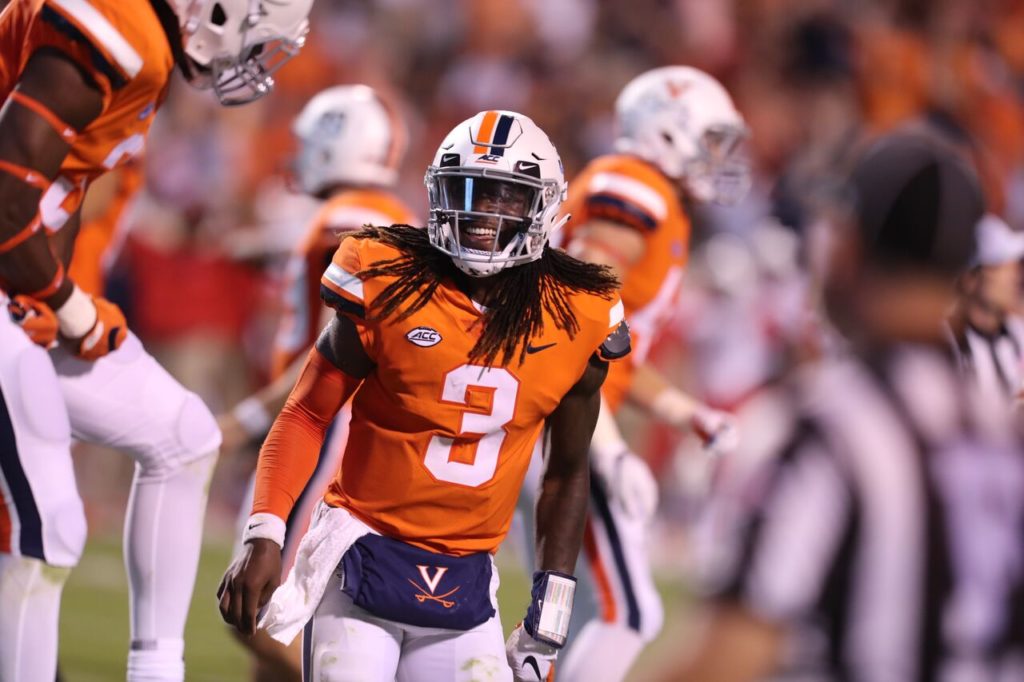
ACC: Virginia Cavaliers
Virginia was projected to finish sixth in the ACC by USA TODAY, but that feels like it could end up being a mistake if quarterback Bryce Perkins can build off his ridiculously excellent 2018 season.
Perkins proved to be one of the more dynamic players in college football last season, throwing for 2,680 yards with 25 touchdowns and nine interceptions, and running for 923 yards and nine scores.
The team will need to replace running back Jordan Ellis and receiver Olamide Zaccheaus, no easy task, but they do return nine starters to a defense that allowed the 20th fewest points last season.
A top-3 finish in the ACC seems very plausible for Bronco Mendenhall’s squad.
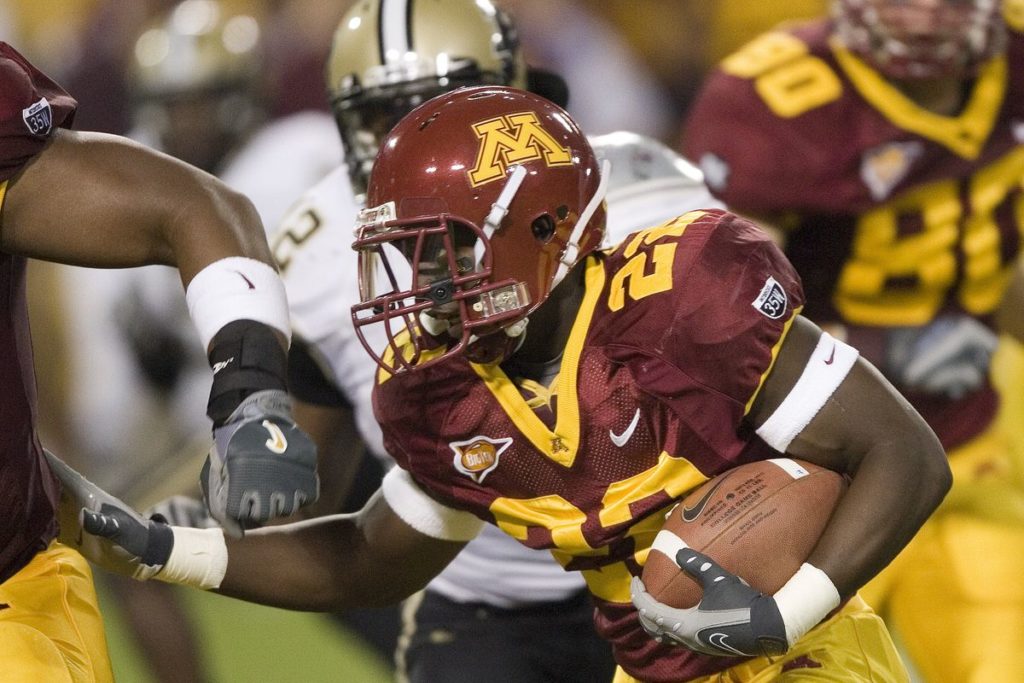
BIG-10: Minnesota Golden Gophers
Minnesota has a lot of things going for them in the BIG Ten, and could be a scary team if things go their way. For starters, they have one of the easiest schedules in college football, and could easily find themselves 5-0 in October.
Second, they return nine starters on offense and seven on defense, which includes receiver Tyler Johnson and a pair of former 1,000-yard rushers in Mohamed Ibrahim and Rodney Smith.
The Gophers finished 2018 winning three out of four, and could realistically challenge for a BIG-10 championship this season if things go right for P.J. Fleck and company.
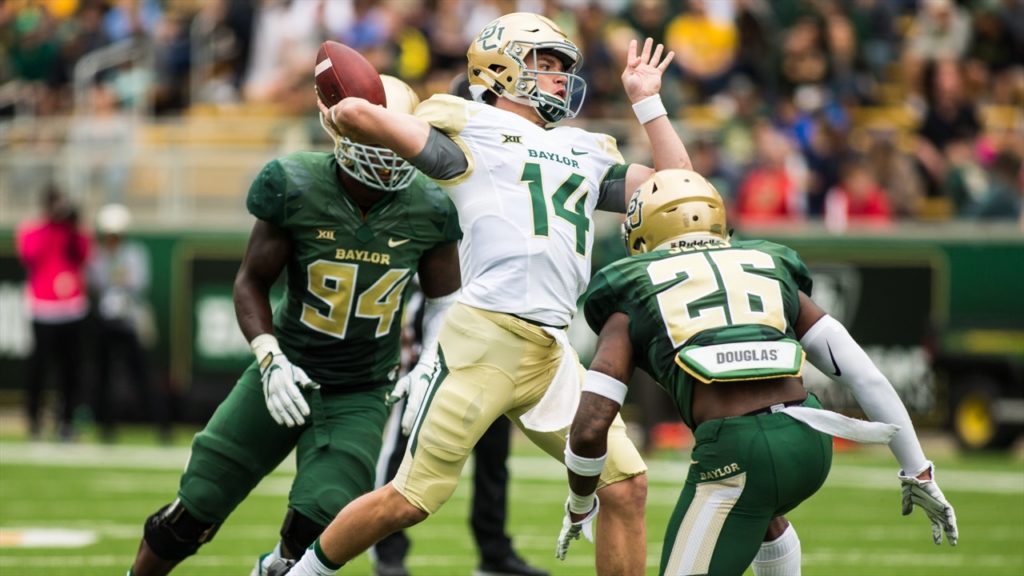
BIG-12: Baylor Bears
Baylor went from one win in 2017 to seven wins in 2018, the second year under coach Matt Rhule. USA TODAY has them 22nd overall, so it’s hard to call them a dark horse necessarily, but Rhule’s squad is only picked to finish fourth in the BIG-12, and I think they can challenge for the top spot.
The Bears have one of the deepest groups of wide receivers in the country, and quarterback Charlie Brewer is coming off a season where he threw for over 3,000 yards with 19 touchdowns.
With an offense poised to do some damage through the air, and a team that has continued to improve in the last few seasons, Baylor has a chance to make some noise in 2019.
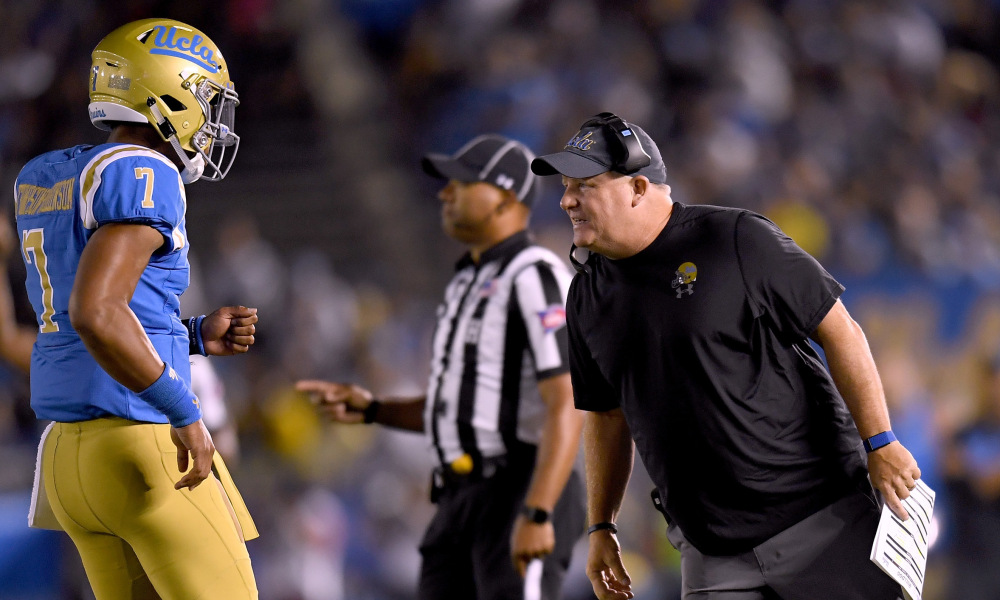
PAC-12: UCLA Bruins
Chip Kelly has proven he can win at the college level. His offensive style is no longer as unique and unknown as it was when he was leading Oregon to prominence a half-decade ago, but there’s reason to believe that the Bruins will begin to hit their stride in the second year under Kelly.
After all, the Bruins did show improvement in the second half last season, and they are returning a good chunk of starters on both sides of the ball.
While they have one of the toughest schedules in the entire college football landscape this year, they could certainly surprise some people heading into conference play.
USA TODAY has them ranked ninth in the PAC-12, and a top-five finish wouldn’t surprise me at all.
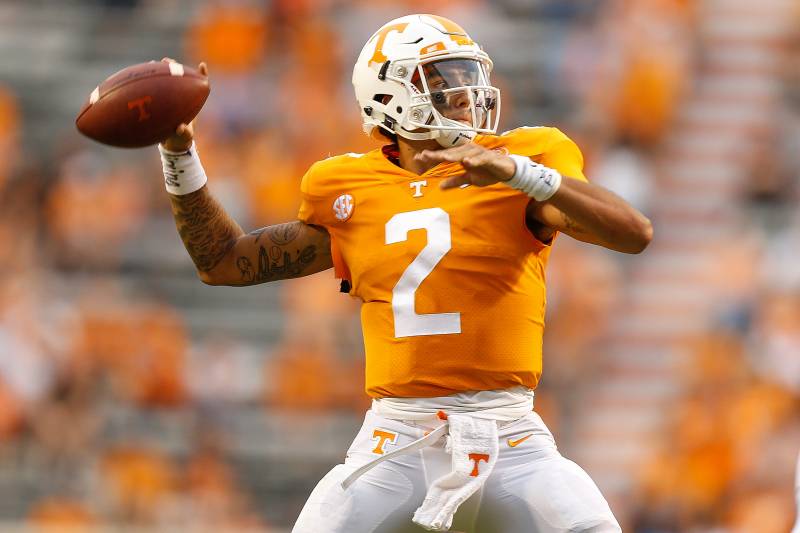
SEC: Tennessee Volunteers
The Vol’s may have lost defensive lineman Emmitt Gooden, but they still have a packed house upfront – especially if they can get Michigan transfer Aubrey Solomon cleared before the opener.
The defense should be solid, but this team’s ability to succeed next season will depend on how quarterback Jarrett Guarantano develops under new offensive coordinator Jim Chaney.
Guarantano had some electric performances last season, particularly against Kentucky, which helped make him the 21st ranked quarterback in college football according to Pro Football Focus.
However, poor offensive line play limited his playmaking ability, and that is something that Tennessee will need to improve if they want to rock the boat in the stacked SEC conference.
These college football Power 5 sleeper teams may not win their conference but they will win games that decide who does.
Colson Yankoff vs Washington, Pac-12 Stadiums Ranked, Recruits Leaving Pac-12 Country
In Episode 3 of the Pac-12 Apostles Podcast, they deal with George Wrighster’s tweet about Colson Yankoff that sent Washington Huskies fans into a tailspin. They rank the best Pac-12 stadiums and tell everyone what is going on with recruits leaving Pac-12 states for other conferences.
Colson Yankoff is a former QB for Washington who transferred to UCLA. Huskies coach Chris Petersen refused to grant a waiver allowing Yankoff to appeal to the NCAA for immediate eligibility at UCLA. Both Ralph and George hate the hypocrisy in the NCAA system. The NCAA claims the players are student-athletes who need to be protected but regularly treats them like employees. It is ridiculous that coaches can move as they please from school to school, but the players have restrictions. (0:00-11:59)
Recruiting matters in college football. The teams with the most talent have the best chance to win the CFB Playoff and National Championship. There are 64 recruits in the 2020 class with either 4-5 stars who live in Pac-12 states or neighboring states. With the exception of the Oregon Ducks and Washington Huskies, the conference is falling behind in the recruiting rankings for the class of 2020. The early signing period is not until December, but the USC Trojans are ranked between 60th and 68th depending on which recruiting site you like. (12:00- 23:41)
The greatest Pac-12 podcat in all the land also ranks the best Pac-12 stadiums from #12 to #1. Will the historic sites get the top spots, or will the stadiums with the biggest home-field advantage prevail? (23:42-End)
Download the Pac-12 Apostles Podcast on any platform.
Anchor // Spotify // PocketCasts // Google Play // Stitcher // RadioPublic
Ten Pac-12 Players Who May Be NFL Draft 2020 First-Round Picks
The PAC-12 may not be viewed as the powerhouse that the SEC is, but make no mistake, each year plenty of high-quality talent is selected in the NFL draft out of PAC-12 schools.
It’s too early to tell, but players like Andre Dillard (WSU), Byron Murphy (UW) Marquise Blair (Utah) and Kaleb McGary (UW) all have a chance to make an immediate impact in the NFL after getting drafted last season.
The 2019 college football season is nearly upon us, and once again the PAC-12 has numerous candidates who might hear their name called early on draft day next season.
10 players out of the PAC-12 who have a realistic chance of getting selected in the first round of the 2020 NFL draft.
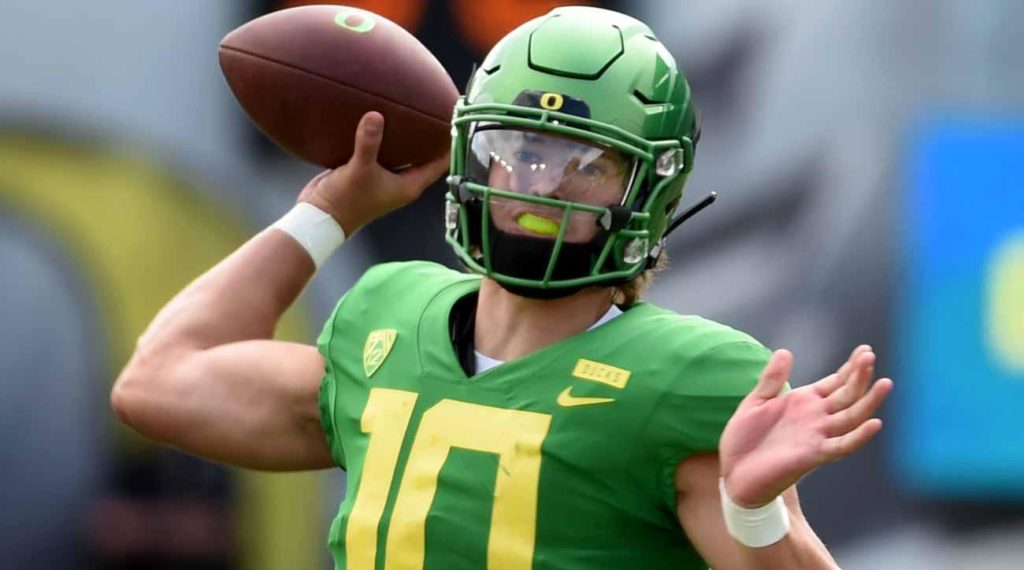
Justin Herbert, Quarterback, Oregon
Herbert is not only a near-lock to go in the first round next season – barring an injury – he has a great chance to go No. 1 overall. It was definitely a surprise when the star quarterback elected to return to college for his senior season, coming off a junior year where he threw for 3,151 yards with an excellent 29-to-8 touchdown-to-interception ratio, leading the Ducks to a 9-4 record.
Herbert said he felt he had unfinished business with the Ducks, and he’ll return as an immediate candidate for the Heisman trophy, alongside Alabama quarterback Tua Tagovailoa.
Herbert has been praised for his ball placement, knowledge of the game and his sneaky mobility, although durability concerns and a tendency to stare down receivers could hurt him at the professional level.
Expect Herbert to be the first PAC-12 player selected next year, and possibly the first player overall.
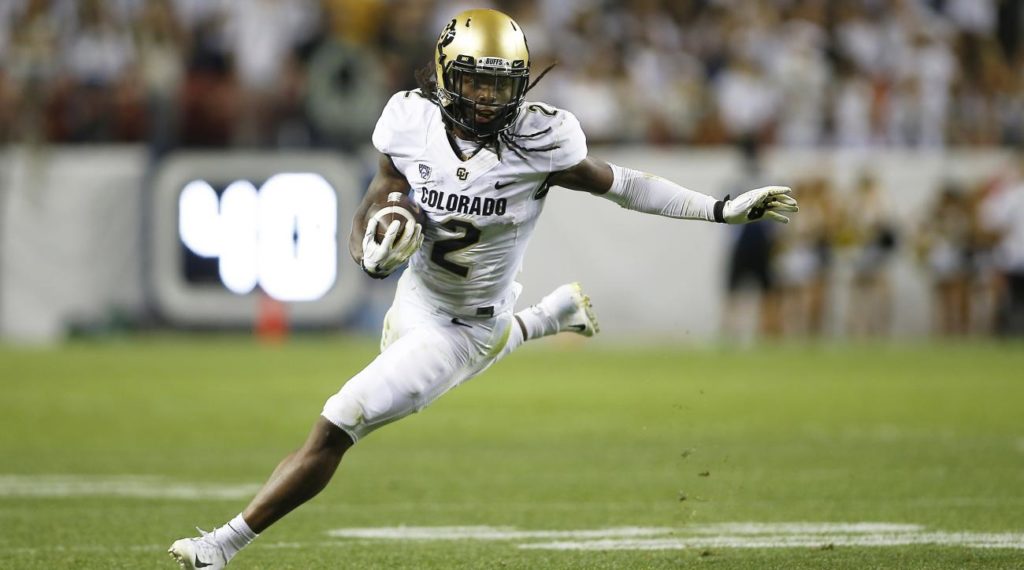
Laviska Shenault, Receiver, Colorado
Laviska Shenault is not only one of the best names in the PAC-12 (more on that later) but he has a real chance to be a top-10 pick in the 2020 NFL draft, particularly if he can build off an incredible junior season.
At Colorado, Shenault hauled in 86 receptions for 1,011 yards and six touchdowns, while also carrying the ball 17 times for 115 yards and five more touchdowns.
Shenault is listed at six-foot-two and 215 pounds, and most scouts think he’ll time out around a 4.40, which gives him an extraordinary blend of size and speed.
He’s still a bit raw as a receiver, but his versatility, size, speed, and instincts make it easy to see him as a future star – and one that should get drafted early in 2020.
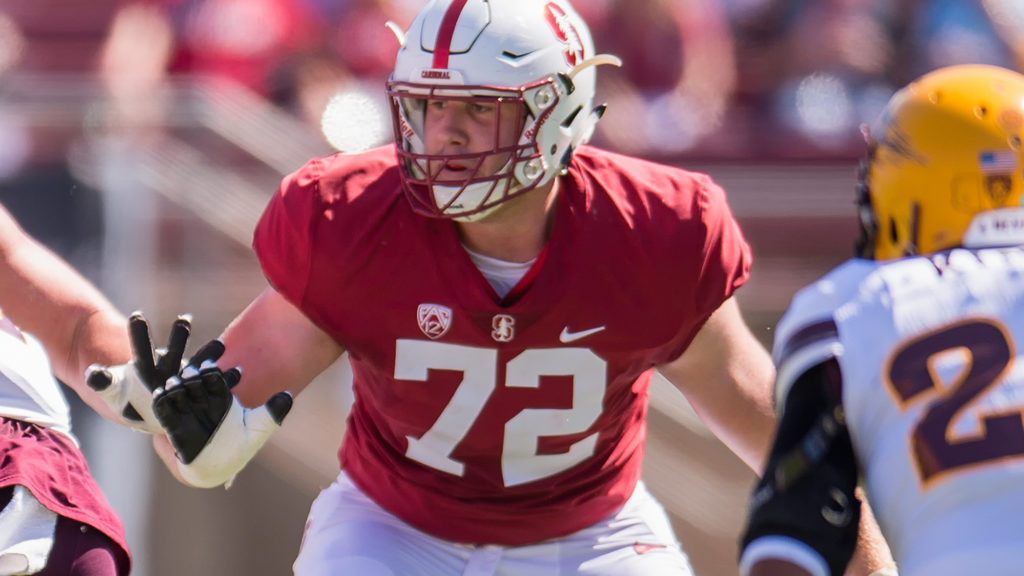
Walker Little, Tackle, Stanford
Stanford tackle Walker Little is anything but – standing at six-foot-seven and weighing 317 pounds. He was co-freshman offensive player of the year in the PAC-12 two years ago and was an absolute beast at clearing rushing lanes for Bryce Love of the Cardinal.
Little is already projected as a mid-first round pick, and if he can stay healthy (he’s battled injuries in the past) there’s little reason to assume he won’t find himself as an NFL starter as soon as 2020.
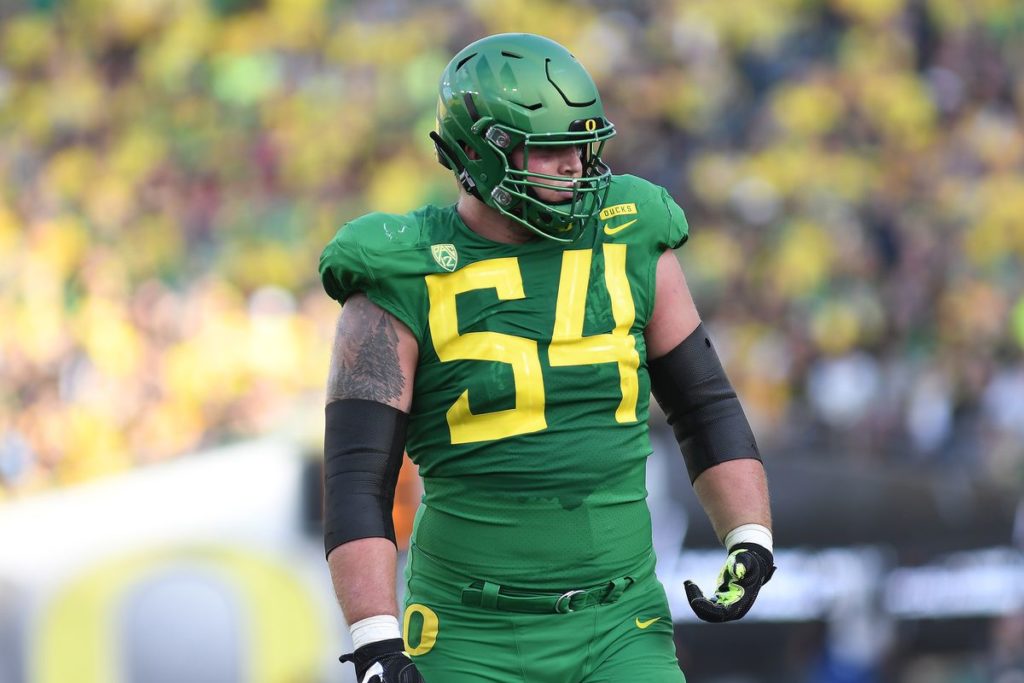
Calvin Throckmorton, Tackle, Oregon
On nearly any other list, Laviska Shenault would be the best name. However, it’s pretty darn hard to beat Oregon tackle Calvin Throckmorton, a name that sounds like it belongs in the Harry Potter universe.
Throckmorton is listed as a tackle, although he has experience as a guard as well – and many analysts believe that is where he will end up in the NFL.
His explosiveness is nearly unparalleled, and his ability to pull and locate blockers makes him an attractive piece to run-heavy NFL squads. He does struggle out in open space however and might be a liability as a pass-blocker.
Throckmorton will have to mitigate some of those concerns if he wants to end up in the first round, but his size, explosiveness, and high football IQ make him a tantalizing prospect entering his fifth season at UO.

Trey Adams, Tackle, Washington
Trey Adams is an absolute unit, standing at six-foot-seven and weighing over 300 pounds. Despite that he has shown good body control as a pass-protector, making him a potential left tackle in the NFL and capable protector of the blindside.
Durability is a big concern here, as the UW star has missed big chunks in each of the last two seasons. He’ll need to be healthy and productive next season if he wants to find himself getting selected in the first round, but he does have the talent to go that high.
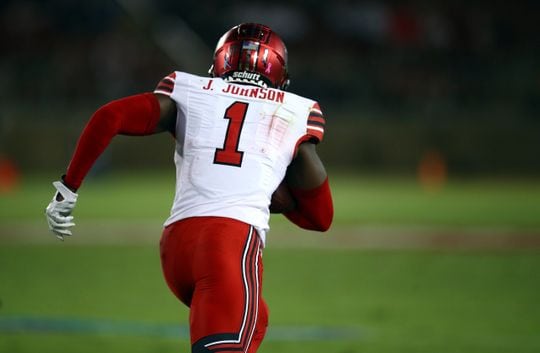
Jaylon Johnson, Cornerback, Utah
Jaylon Johnson enters his third season at Utah coming off a sophomore campaign that saw him snag four interceptions, along with 31 solo tackles and two sacks.
Johnson has the near-perfect size for an NFL corner, standing six-foot and weighing 190 pounds. He’s physical and aggressive at the point of contact, making him a great asset against bigger, more physical NFL receivers.
He’s raw, and has some issues in quick throws. But Johnson has the tools and build to be a high-quality defensive back in the NFL. He could find himself getting picked in the first-round of the NFL Draft if he has a strong junior campaign.

Jacob Eason, Quarterback, Washington
The range of outcomes that are possible for new Huskies quarterback Jacob Eason is nearly infinite.
The transfer from Georgia sat out last year but is expected to start for Chris Peterson and company next season. Eason wasn’t bad the one season he started at Georgia, completing 55.1% of his passes for 2,430 yards with a nice 16-to-8 touchdown-to-interception ratio.
But after losing his job to Jake Fromm, Eason will have to prove himself in the Pacific Northwest. If he can harness his absolute cannon of an arm, he could easily find himself getting selected by a QB needy team in the first round.
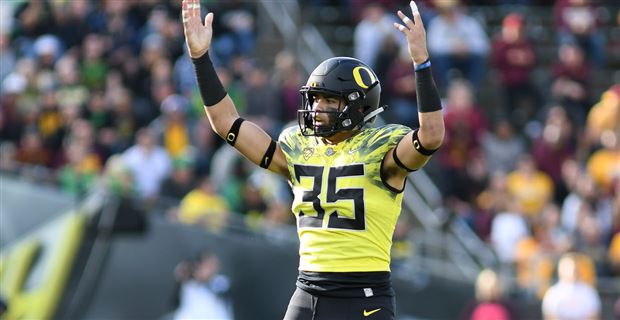
Troy Dye, Linebacker, Oregon
Dye has started for the Ducks over the past three seasons, posting remarkably consistent numbers throughout his career. His 182 solo tackles are already 22nd all-time in the PAC-12, and his 125 assisted tackles rank 16th.
Dye possesses excellent range and instincts as a linebacker, and his size and style of play should mesh well with the current NFL style.
He does have some issues in run protection, often relying on seeing the ball-carrier and chasing them rather than anticipating, but those are things he can learn at the pro level. It would take a step forward from Dye for him to jump into the first round, but as it stands he has a great chance to be a high-quality NFL starter for a long time.
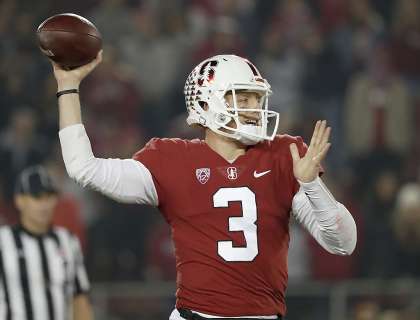
K.J. Costello, Quarterback, Stanford
Scouts, coaches and general managers love their tall quarterbacks. It’s why Paxton Lynch was an NFL Draft first-rounder and Russell Wilson fell into the third – even though Lynch is now fighting for a job backing up Wilson in Seattle.
K.J. Costello stands six-foot-five and weighs a lean 215 pounds, and his size and absolute rocket arm make him an appealing potential first-round target next season.
He led the Cardinal to a 9-4 record by throwing for 3,540 yards with a nice 29-to-11 touchdown-to-interception ratio and a solid 65.1% completion percentage.
Costello’s IQ in the pocket is excellent, and he has complete trust in his receivers – often making challenging throws and seeing openings before anyone else can.
He’s a bit limited mobility wise – as most six-foot-five quarterbacks are – but another strong season could vault Costello into the first-round conversation, particularly if multiple quarterback-needy teams emerge. He may end up being a Pac-12 NFL Draft first-rounder.

Christian Rector, EDGE, USC
EDGE defenders were all the rage in the NFL Draft first-round last year, and while the PAC-12 doesn’t have a huge laundry list of elite, draft-eligible pass-rushers in 2019, one who could sneak his way into first-round consideration with a strong campaign is USC’s Christan Rector.
Entering his fifth year with the Trojans, Rector will need to show consistency if he wants to get attention at the top of the NFL Draft. An imposing six-foot-four and 270 pounds, Rector can absolutely wreak havoc off the edge – but too often he disappears for entire games.
His hand placement and use of length have been strengths of his in the past, but he often gets too upright and struggles to fill gaps in the run-game – both traits that he’ll need to improve on in his final season down in Southern California.
Pac-12 Apostles: State of the Conference, Predictions, Preview Podcast
Anchor // Spotify // PocketCasts // Google Play // Stitcher // RadioPublic
George Wrighster and Ralph Amsden return for the second installment of UnafraidShow.com’s Pac-12 Apostles Podcast. In this episode, the guys discuss the critical nature of the 2019 season for the Pac-12 conference, as well as the responsibility of the fans to help keep the conference from becoming irrelevant before the tv deal is up in 2024. The conference is falling financially behind the other power 5 conferences. So, winning a national championship or two before 2024 is paramount to the future of the Pac-12.
One of the biggest potential changes for the upcoming season in the Pac-12 is the proposed 9 am kickoff times for a small selection of games meant to air on Fox. George and Ralph discuss the pros and cons of early kickoffs and debate whether or not there will ultimately benefit from the change (14:00-31:38).
Pac-12 Apostles Podcast North and South Predictions

George and Ralph revealed their preseason predictions for where the Pac-12 North teams will finish. Oregon, Washington, and Stanford have been the class of the Pac-12 for the last decade. But, both of the apostles believe Cal is a well-coached team on the rise. (31:39-1:01:11).,
The media picked Utah to win the conference at Pac-12 Media Day. However, neither George or Ralph picked them to win the south division. The apostles’ predictions for the Pac-12 South teams caused a big disagreement. They could not be further apart on the predictions for the UCLA Bruins, USC Trojans, and Arizona QB Khalil Tate. (1:01:12-End).
Download the Pac-12 Apostles Podcast on any podcast platform.
Anchor // Spotify // PocketCasts // Google Play // Stitcher // RadioPublic
What Happens if California Calls the NCAA’s Bluff of Post Season Bans?
The NCAA has once again shown its true objective. That objective is ensuring that college athletes do not receive any financial benefit that is not NCAA approved. On June 24th, it was reported that NCAA president Mark Emmert sent a letter to the California State Assembly. The letter informed the California State Legislature that the NCAA may ban California colleges from participating in NCAA championships if The Fair Pay to Play Act is passed. The Act aims to allow college athletes to profit from the commercial use of their name, image, and likeness (NIL).
That is right, the NCAA seeks to punish California schools if the state passes a law that would benefit college athletes. The bill was proposed by California state senators Nancy Skinner and Steven Bradford in February. Last month, the California State Senate passed the bill. It is very likely that the bill will continue to pass through the California Sate Legislature and become law. This high probability led the NCAA to send that letter in an attempt to impede the bill’s progress.
What Happens if the Bill Becomes Law in California?
If the bill is signed into law, it will not go into effect until 2023. At that time, college athletes in California would be allowed to garner endorsement deals and sign with agents. The schools would not be paying the athletes. The athletes would get paid from outside sources. Therefore, the bill does not pose any Title IX implications. It also will have no effect on non-revenue producing sports. However, the NCAA wants the bill’s progress postponed until their working group has had a chance to address the matter.
The NCAA Creates Working Group to Address Issues Related to College Athletes’ NIL
On May 14th, the NCAA announced that it created a working group to address issues regarding college athletes’ ability to profit from the commercial use of their NIL. The NCAA created this working group in response to several bills, similar to the one in California, being introduced at both the state and federal levels. A bill was introduced in Washington state that aims to allow college athletes in Washington to profit from the commercial use of their NIL. At the federal level, Congressman Mark Walker of North Carolina introduced the Student-Athlete Equity Act. The Act purports to amend the tax code so that amateur sports organizations such as the NCAA can no longer strip athletes of their right to profit from their name, image, and likeness.
In an effort to get ahead of the issues raised in these bills, the NCAA created the working group. Many were skeptical of the actual goals of the working group. Many questioned whether the NCAA would actually amend the rules in a favorable manner for college athletes. The letter the NCAA sent to the California State Legislature has painted a bleak picture for any hope that the NCAA will make rule changes that benefit college athletes in a meaningful way. After all, the NCAA recently announced that it may tighten up on college athletes’ ability to transfer.
Last summer, the NCAA passed a new transfer rule that served as a major benefit to many college athletes by allowing them to be immediately eligible upon transfer. After complaints about college athletes newfound freedom, the NCAA announced that it may be issuing tighter guidelines for schools to consider in determining an athlete’s immediate eligibility. The NCAA’s announcement regarding the transfer rule does not leave much hope for the efforts of the working group. However, what the working group will actually do remains to be seen. In the meantime, California should call the NCAA’s bluff and move forward with the progression of the bill. After all, how likely is it that the NCAA will carry out its threat?
Will the NCAA Make Good on its Threat?
California is home to some of college sports premier programs. Stanford, University of California Los Angeles, and the University of Southern California all have renowned sports programs. These schools are also members of the Power 5 Conference, the Pac 12. The Pac-12 Conference would be directly affected if the NCAA makes good on its threat. However, the Pac-12 seems to support the efforts of the NCAA’s working group. The Unafraid Show reached out the Pac-12 Conference for comments regarding The Fair Pay to Play Act and Mark Emmert’s letter.
The Pac-12 responded with a letter that the conference’s commissioner Larry Scott sent to the chairman of the California State Legislature Arts, Entertainment, Sports, Tourism, and Internet Media Committee on June 14, 2019. The Pac-12’s letter was sent to the California State Legislature prior to the report of NCAA president Mark Emmert’s letter. In the Pac-12’s letter, Mr. Scott requested that the committee hold the bill until the NCAA’s working group finalizes its work this fall. The letter stated Pac-12 athletic director Rick George of the University of Colorado, Boulder joined the committee. Mr. Scott also stressed the Pac-12’s commitment to protecting and supporting the welfare of student-athletes. The Pac-12 Conference did not comment on Mark Emmert’s letter.
It is Time for Change in College Athletics
Although the Pac-12 would prefer the California State Legislature postpone the bill, the California State Legislature should do just the opposite. The California State Legislature should call the NCAA’s bluff. California is home to some of college sports premier programs. Does it really make sense that the NCAA would prohibit all of California’s colleges from competing in championships? The NCAA has too much to lose. The organization has its broadcasting deal with CBS Sports and Turner a division of Time Warner to consider. Would the NCAA really risk losing money on that deal by not making the California colleges’ games available? The answer is no. The NCAA did not become a billion dollar non-profit organization by missing opportunities to maximize their profit margin. After all, if the NCAA did not punish UNC for creating sham courses why would the NCAA punish California for passing a law that benefits college athletes? Therefore, California should call the NCAA’s bluff and continue to fight for what is right.
California should set an example by passing The Fair Pay to Play Act. It is very likely that other states would follow suit for competitive reasons if nothing else.
The NCAA has shown time and again that their aim is to prohibit the financial benefits of college athletes as much as possible in the name of amateurism. Amateurism is a sham. That has been proven by the exorbitant coaching contracts that are signed year after year. The NCAA will only authorize changes in college athletics when forced to. They only created the working group after several state and federal bills were introduced and gaining traction. California should call the NCAA’s bluff and continue to push the bill through. At the very least, California could force the working group to amend the rules so that college athletes can finally profit from the commercial use of their own face and name.
Follow Kassandra Ramsey @Court_2_Court

